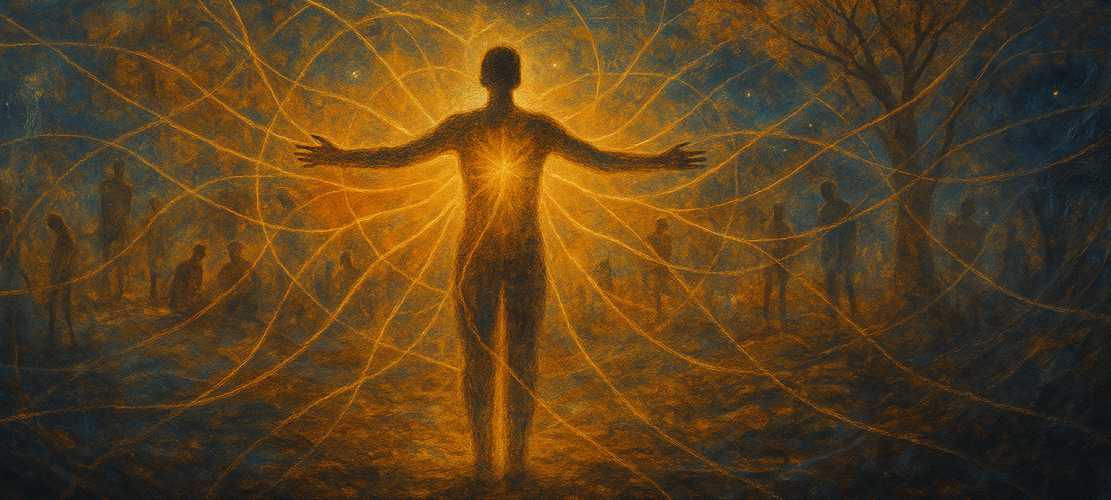
You are Not an Object: Reimagining Your Presence in the World
A foundational belief many of us carry unconsciously is the idea of ourselves as distinctly separate, bounded objects navigating through a world of other distinct objects. This perception frames our identity and experience as isolated and solitary just a self-contained entity bumping into others, interacting but essentially disconnected. What if this pervasive view, deeply embedded in our language, our thinking, and even our bodily sensations, is fundamentally limited? What if, instead, our essential nature is inherently relational, a continual dialogue with the world around us?
When we deeply reconsider the concept of space and time, not merely as empty containers but as vibrant fields of continuous interaction, our self-perception begins to shift profoundly. We start to see ourselves less as isolated beings and more as integral participants in an ongoing, dynamic conversation. Space and time cease to be mere passive backdrops; instead, they become active co-creators of our existence, constantly shaping us even as we shape them.
Breaking Free from the Myth of Isolation
Early on, we learn implicitly that we are fundamentally separate from our surroundings: my body, your body, this object, that object. This boundary is taught and reinforced repeatedly, becoming so intuitive that we rarely question its validity. But on closer examination, this sharp boundary dissolves under scrutiny. Our bodies continuously exchange air, nutrients, energy, and information with the environment around us. Our thoughts and emotions respond moment-by-moment to the contexts we inhabit. These interactions aren’t peripheral, they constitute our very being.
Recognizing this truth prompts us to reconsider our fundamental assumptions about separation. The boundary of “self” is less a barrier and more a permeable membrane, continuously allowing passage and exchange. In acknowledging this permeability, we understand ourselves not as isolated entities but as active participants in a web of relational processes.
Space and Time as Active Participants
To see ourselves relationally means recognizing spacetime itself as participatory. We aren’t objects moving through passive, inert space. Rather, our presence reshapes the spaces we occupy, transforming atmospheres, altering moods, shifting energies. Entering a room, our presence isn’t neutral, it evokes subtle responses in the people around us and changes the context in tangible and intangible ways.
Similarly, time is not simply linear progression; our experience of it shifts dramatically based on our emotional and relational states. Engaged deeply, we experience time differently than when we are anxious or bored. Time becomes a dynamic interaction, a lived conversation between ourselves and the unfolding world.
Your Body as a Relational Field
Rather than viewing your body as a mere object in space, consider it instead as a dynamic relational field. Your breath, heartbeat, posture, and bodily sensations are continuous interactions, a kind of ongoing conversation with your environment. Feeling cold or warm, comfortable or uncomfortable, these aren’t isolated sensations but embodied responses to your relational context.
When we reframe bodily experiences relationally, we open ourselves to deeper understanding and awareness. Anxiety, rather than an isolated internal condition, is revealed as a relational disruption. It is a misalignment within the interactive field of our lives. This relational reframing moves us toward healing, inviting us to reestablish equilibrium by realigning our relational patterns internally and externally.
Healing Through Relational Alignment
As a counselor, I’ve often observed the power of shifting therapeutic approaches from isolated symptoms toward understanding relational patterns. Anxiety, depression, and isolation aren’t solely internal issues to “fix.” Instead, they signify disruptions in relational coherence, in a sense patterns needing realignment and healing.
This relational understanding of healing reframes our struggles not as individual weaknesses but as invitations to reconnect. We seek coherence not by isolating or dissecting ourselves but by reengaging, recalibrating, and restoring balance within our relational fields. Our deepest healing comes from reconnecting with ourselves, each other, and the broader world.
Embracing Our Relational Identity
When we truly embrace ourselves as fundamentally relational, we begin to recognize the profound interconnectedness of all things. This recognition is more than intellectual; it’s deeply embodied, felt in our bones, resonant in our emotional and spiritual lives.
This relational awareness is profoundly liberating. Rather than defending and isolating ourselves, we find freedom in connection. Our lives become richer, fuller, and more meaningful as we recognize our integral role in the unfolding narrative of relational spacetime.
We are not isolated objects passing through a passive world; we are active participants in a vibrant, dynamic, living web of relationships. Understanding this is to step into a reality of profound interconnectedness, a reality inviting us into deeper intimacy with ourselves, each other, and the very fabric of existence itself.
